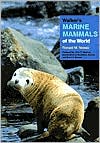

 |

|

The average rating for Walker's Marine Mammals of the World based on 2 reviews is 5 stars.
Review # 1 was written on 2018-03-15 00:00:00 Harry Birk Harry BirkGeorg Rumpf was born in Germany during the anarchic period of early the early 1600's. His father was an engineer who taught Georg design, mathematics and project management. In his schooling he showed more of a preference for the arts and languages. After joining the army as a young man, he was transported to Portugal, eventually making his way to Indonesia and being engaged by the Dutch East India Company (VOC). His engineering skills combined with his ability to effectively work with the local people and learn their language lead to increasingly responsible positions, eventually that of second merchant in Ambon. This position allowed him time to pursue natural history. As his work transitioned from business to study he Latinized his name to Rumphius. While his most important book was the 6 volume "Herbarium Amboinense" describing the plants of Ambon, the Curiosity Cabinet concentrates on invertebrates and minerals. The name makes reference to cabinets that were kept by some to house curios, including those of the natural world. It is amazing that these books are available considering the number of tragedies that befell Rumphius, including loss of his papers due to sinking ships, loss of his family to an earthquake and loss of his sight in 1670 due to glaucoma. The "Herbarium Amboinense" was not published until 39 years after his death. Rumphius was guided by the writings of Aristotle and Pliny the Elder who were still authorities at the time. Rumphius uses a naming convention consistent to the binomial system that was evolving at the time. While Linnaeus published his "Systema Naturae" before Rumphius' works were published, Linnaeus did include a number of Rumphius' species in addenda. Neither Darwin nor Wallace mentioned the work of Rumphius even though Wallace spent three years on Ambon. In "The Ambonese Curiosity Cabinet" Rumphius describes numerous species, providing a Latin name - such as Cancer Crumenatus for the Coconut Crab; the local name, an anatomical description plus notes on the environment, behaviour and human use of the animal. He had illustrations made of many of these animals, and these were supplemented by the publisher with illustrations from private collections. Even today the descriptions are of interest. At times it is not easy to determine the creature where an illustration is not provided. For example, careful reading and a bit of investigation are needed to determine that Sagitta Marina or the Sea Dart is a sea pen (Virgularia), and Phallus Marinus is a sea cucumber. Even where English names are provided (by the publisher?), they are dated - a sea apple is now commonly called an urchin. The first book includes a variety of animals that are not univalves or bivalves, including shrimp, crayfish, crabs, urchins and lesser animals. Reference is made to toxic crabs: Cancer Noxius. Rumphius describes the hermit crabs (Cancelli) that cause him grief when he lays out handsome shells to bleach and they steal them at night. A major focus of the descriptions is the use of various animals and objects as medicines - here he talks of the use of an extract from the hermit crabs that can be used to treat cold sores. The local fisherman found the basket star to be fearsome and would not touch it, while the older men (Orang Lamma - ancient) realized they were harmless. The second book is devoted to shells, but includes the Nautilus. Also of interest are the giant clams which he terms Chama Decumana, locally Bia Garu and Father Noah shells in English. Rumphius was the first to describe them. As pieces of these shells are found in the hills, Rumphius reasons how they got there. Being unaware of the processes of land uplift, he concludes that they were deposited by the great flood. In chapter 38, Rumphius compares his division of the shells that that of Pliny, being based on shell shape rather than the anatomy of the animal - hence the inclusion of the Nautilus. The third book covers minerals, alloys, glasses, ambergris and a variety of curious objects, including stones from a variety of sources to which all kinds of powers are attributed. As the true source of most of these were unknown, Rumphius relates many of the ideas of the time. Thunder Shovels were iron objects that resembled tools. While likely archaeological objects from earlier people, Rumphius attributes them to thunder and lightning - he has no difficulty with the idea that vapors draw metallic substances from the mountains into the clouds which are then smelted by lightning. The fact that they are forged into the shape of tools is attributed to the Astral influence over Man so that the Astral smith controls the lightning's products to form tools. Porcelain had been highly valued by the islanders. As it was used only for very special occasions, it was buried in the interim to protect it from theft. Some types were called poison plates and were thought to detect poisons by cracking on the surface. Some, such as these made for Sampo (the great Chinese admiral Zheng He), were held to be able to neutralize poisons. |
Review # 2 was written on 2016-06-29 00:00:00 Jon Courtney Jon CourtneyWe really enjoyed this one, perfect for ages 4-7. |
CAN'T FIND WHAT YOU'RE LOOKING FOR? CLICK HERE!!!